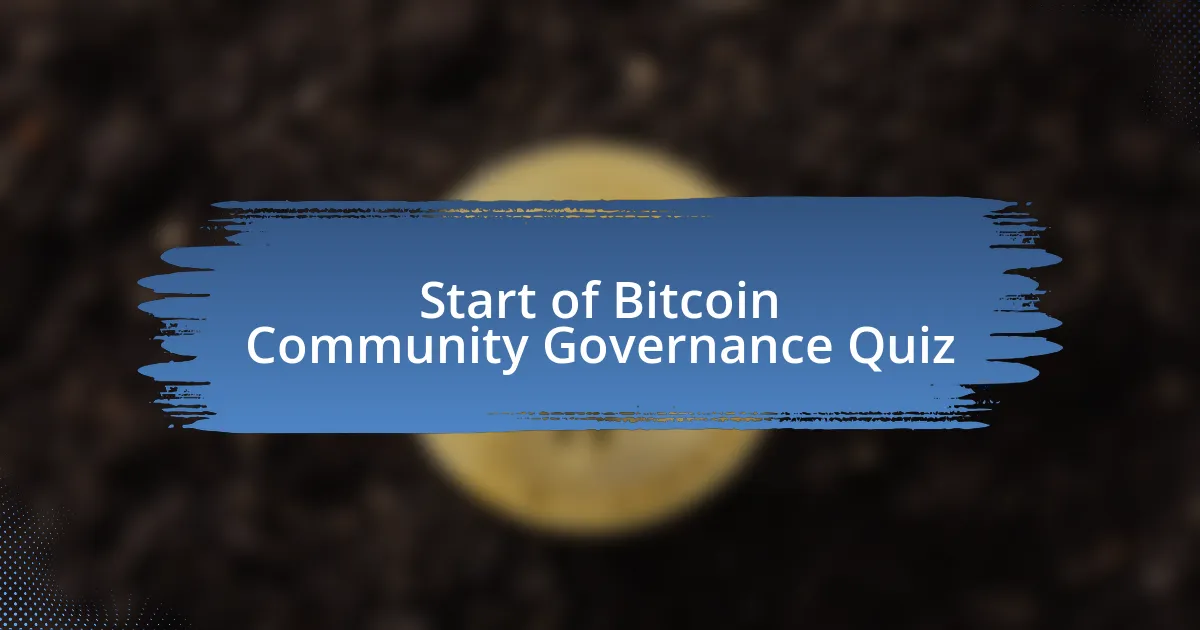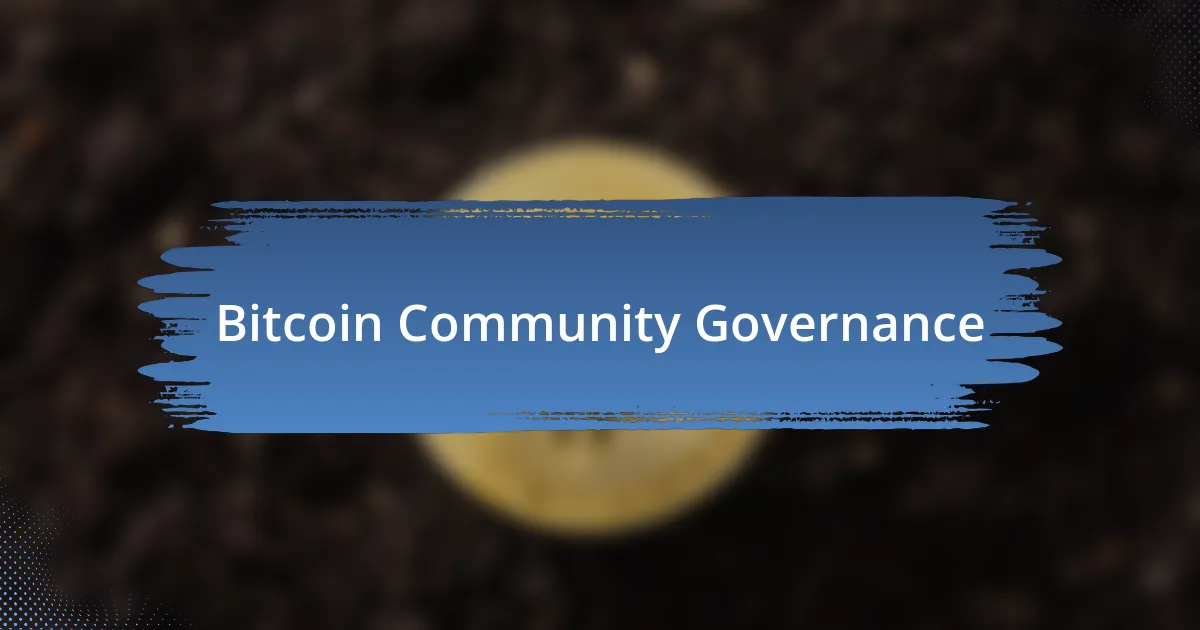
Start of Bitcoin Community Governance Quiz
1. Who controls changes to the Bitcoin network?
- Miners, developers, users, and node operators collectively control changes to the Bitcoin network.
- A single CEO manages changes to the Bitcoin network.
- The Federal Reserve controls changes to the Bitcoin network.
- The government solely decides changes to the Bitcoin network.
2. What is the primary mechanism for resolving governance issues in Bitcoin?
- On-chain voting
- Off-chain governance
- Centralized authority
- Legal frameworks
3. What is the role of miners in Bitcoin governance?
- Miners are responsible for creating new wallets.
- Miners manage the marketing strategies for Bitcoin adoption.
- Miners validate transactions and secure the network.
- Miners design the user interface for Bitcoin applications.
4. How does Bitcoin`s decentralization impact its governance?
- Bitcoin`s governance structure is entirely based on corporate-like hierarchy and leadership roles.
- Bitcoin`s decentralization allows users to vote individually on all network changes.
- Bitcoin`s decentralization means that no single person or entity has complete control over the network, distributing authority and control among various stakeholders.
- Bitcoin`s governance is managed by a central authority which makes all the key decisions.
5. What is the significance of the Proof-of-Work (PoW) consensus mechanism in Bitcoin governance?
- The PoW consensus mechanism ensures effective governance by making it impossible to cheat the Bitcoin blockchain system due to the high cost involved in doing so, ensuring honesty through economic incentives.
- The PoW consensus mechanism primarily focuses on enhancing transaction speeds with no effect on governance.
- The PoW consensus mechanism centralizes power in the hands of a few major miners, undermining network fairness.
- The PoW consensus mechanism allows unlimited energy usage, leading to environmental degradation without governance impact.
6. Who are the key stakeholders involved in Bitcoin governance?
- The key stakeholders include bank executives, regulators, investors, and miners.
- The key stakeholders include politicians, corporate shareholders, developers, and miners.
- The key stakeholders include miners, developers, users, and node operators.
- The key stakeholders include economists, financial analysts, users, and regulators.
7. How does Bitcoin`s transparency impact governance?
- Bitcoin`s transparency leads to increased conflicts among stakeholders, complicating governance.
- Bitcoin`s blockchain transparency minimizes information asymmetry between stakeholders, reducing opportunities for opportunistic behavior.
- Bitcoin`s transparency encourages monopolistic behavior by allowing some users to dominate.
- Bitcoin`s transparency creates barriers to entry that limit stakeholder participation.
8. What is the role of developers in Bitcoin governance?
- Developers shape the Bitcoin protocol and propose network changes.
- Developers set strict rules that all users must follow for the network.
- Developers only fix bugs in the Bitcoin software without influencing changes.
- Developers own all the Bitcoin and control the funds.
9. What are the implications of imposing fiduciary duties on Bitcoin developers?
- Imposing fiduciary duties means that developers can be held legally responsible for market fluctuations or losses incurred by users.
- Imposing fiduciary duties creates a corporate structure where developers must report to stakeholders regularly about their actions.
- Imposing fiduciary duties guarantees that all decisions made by developers are legally binding and transparent.
- Imposing fiduciary duties on Bitcoin developers assumes an agency and trust relationship between developers and users, which is not clearly defined in the Bitcoin ecosystem.
10. How does Bitcoin`s governance structure differ from traditional corporate governance?
- Bitcoin`s governance is led by a centralized board that makes all important decisions.
- Bitcoin`s governance relies solely on a single entity that oversees all changes to the network.
- Bitcoin`s governance structure lacks a clear separation of ownership and control, and it does not rely on traditional corporate governance mechanisms like fiduciary duties.
- Bitcoin`s governance structure involves strict hierarchies and top-down decision-making similar to corporations.
11. What are the advantages of decentralization in Bitcoin governance?
- Decentralization leads to higher fees for Bitcoin transactions due to network congestion.
- Decentralization makes Bitcoin more resilient and resistant to censorship by distributing authority and control among various stakeholders.
- Decentralization increases the speed of Bitcoin transactions by removing the need for approval.
- Decentralization helps centralize power among major stakeholders in the Bitcoin network.
12. What are the challenges in Bitcoin governance?
- The challenges include conflict resolution mechanisms to maintain network integrity and harmony, as well as ensuring that decision-making processes are fair and transparent.
- The challenges involve centralizing authority to streamline decision-making and reduce stakeholders.
- The challenges consist of eliminating developer input to ensure quicker changes to the network.
- The challenges are primarily about creating strict eligibility requirements for all participants in governance.
13. How does Bitcoin`s governance framework handle decision-making?
- Bitcoin`s governance framework relies on a community-driven approach, where network participants must reach a consensus to make changes, promoting trust, transparency, and growth.
- Changes to Bitcoin`s governance are made solely by the developers without any input from users or miners.
- Bitcoin governance is controlled by a central authority that enforces decisions on the network.
- Decision-making in Bitcoin governance is based on majority voting by a select group of stakeholders only.
14. What is the role of node operators in Bitcoin governance?
- Node operators create new Bitcoins and control monetary policy decisions.
- Node operators are responsible for developing software updates without community input.
- Node operators exclusively manage Bitcoin trading and investments for users.
- Node operators play a crucial role in validating transactions and maintaining the integrity of the blockchain by participating in the network.
15. How does Bitcoin`s off-chain governance work?
- Bitcoin`s off-chain governance is managed solely by a central authority that decides on network protocols and changes.
- Bitcoin`s off-chain governance is a system where only developers have the authority to make decisions about the Bitcoin network.
- Bitcoin`s off-chain governance involves decision-making processes that are not directly recorded on the blockchain but are crucial for the network`s functioning and development.
- Bitcoin`s off-chain governance refers to transactions processed outside of the blockchain, ignoring stakeholder input and consensus.
16. What is the Bitcoin Improvement Process (BIP)?
- The Bitcoin Improvement Process (BIP) is a way to gather data on Bitcoin user preferences.
- The Bitcoin Improvement Process (BIP) is a guide for securing Bitcoin wallets against hacks.
- The Bitcoin Improvement Process (BIP) is a method for mining Bitcoins more efficiently.
- The Bitcoin Improvement Process (BIP) is an off-chain decision-making process used to propose and implement changes to the Bitcoin protocol.
17. How does Bitcoin`s governance structure ensure honesty and integrity?
- Bitcoin`s governance structure ensures honesty and integrity through its Proof-of-Work (PoW) consensus mechanism, which makes it economically unfeasible to cheat the system.
- Bitcoin`s integrity relies on the reputation of its developers who can alter the code at will.
- Bitcoin`s governance structure depends entirely on user voting to approve all transactions.
- Bitcoin`s governance is managed solely by a central authority that oversees the blockchain operations.
18. What is the significance of the cryptographic puzzle in Bitcoin`s governance?
- The cryptographic puzzle in Bitcoin`s governance simplifies transaction processes to enhance overall network performance.
- The cryptographic puzzle in Bitcoin`s governance controls user access and prevents unauthorized changes to the blockchain.
- The cryptographic puzzle in Bitcoin`s governance guarantees instant transaction confirmations to improve user experience.
- The cryptographic puzzle in Bitcoin`s governance ensures that only valid transactions are verified and added to the blockchain, maintaining the integrity of the network.
19. How does Bitcoin`s divisibility impact its governance?
- Bitcoin`s divisibility limits its use, making large transactions difficult and inefficient.
- Bitcoin`s divisibility makes it an inflexible currency that cannot adapt to market needs.
- Bitcoin`s divisibility allows for its complete control by a single entity, impacting its governance negatively.
- Bitcoin`s divisibility to eight decimal places allows for a large number of spendable units, making it a versatile and adaptable currency.
20. What is the total number of Bitcoins that can be generated?
- 1 million
- 21 million
- 10 million
- 50 million
21. How does the supply of Bitcoins differ from traditional currencies?
- The supply of Bitcoins is determined by government regulation, similar to traditional currencies.
- The supply of Bitcoins is capped at 21 million, unlike traditional currencies controlled by banks.
- Bitcoins can be printed in unlimited quantities like traditional currencies.
- Traditional currencies have a fixed supply similar to Bitcoins.
22. What is the role of miners in validating transactions?
- Miners create new cryptocurrencies by trading.
- Miners collect fees from users for every transaction.
- Miners verify user identities before transactions occur.
- Miners validate transactions by solving a difficult math problem.
23. How does Bitcoin`s governance structure promote trust and transparency?
- Bitcoin`s governance structure promotes trust and transparency by allowing a single organization to oversee all transactions and changes.
- Bitcoin`s governance structure promotes trust and transparency by distributing authority and control among various stakeholders, ensuring that all transactions are recorded on a public ledger (blockchain).
- Bitcoin`s governance structure promotes trust and transparency by using a centralized server to manage all user activities and records.
- Bitcoin`s governance structure promotes trust and transparency by requiring all users to submit their identities for verification before participating.
24. What are the implications of Bitcoin`s decentralized nature on its governance?
- Bitcoin`s decentralized nature means that control is distributed among various stakeholders, making it more resilient and resistant to censorship.
- Bitcoin`s decentralized nature centralizes power, leading to a single governing authority.
- Bitcoin`s decentralized nature has no impact on its governance or stakeholder involvement.
- Bitcoin`s decentralized nature allows one entity to make unilateral decisions for quick fixes.
25. How does Bitcoin`s governance structure handle conflicts?
- Bitcoin`s governance structure is dictated by a central authority that makes all decisions and rules.
- Bitcoin`s governance structure relies on community-driven approaches and consensus mechanisms to resolve conflicts and maintain network integrity.
- Bitcoin`s governance structure has a single group that resolves conflicts through unilateral decisions.
- Bitcoin`s governance structure ignores conflicts and allows them to persist without resolution.
26. What is the significance of the Bitcoin Depot ATMs in Bitcoin governance?
- Bitcoin Depot ATMs are controlled by a single entity that manages the entire Bitcoin network.
- Bitcoin Depot ATMs provide a convenient way for users to purchase Bitcoins, contributing to the decentralized nature of the network.
- Bitcoin Depot ATMs are primarily used for mining Bitcoin, influencing governance decisions directly.
- Bitcoin Depot ATMs limit user access to Bitcoin, centralizing governance in the process.
27. How does Bitcoin`s governance structure ensure adaptability?
- Bitcoin`s governance structure ensures adaptability through its decentralized decision-making processes and the ability to implement changes through the Bitcoin Improvement Process (BIP).
- Bitcoin`s governance structure is centrally controlled by a single organization that dictates all changes.
- Bitcoin`s governance structure only allows changes through government regulation, which stifles adaptability.
- Bitcoin`s governance structure prevents any modifications, ensuring strict adherence to its original rules.
28. What is the role of users in Bitcoin governance?
- Users play a crucial role in Bitcoin governance by participating in decision-making processes and ensuring that the network remains decentralized.
- Users primarily serve as passive observers in Bitcoin governance without any active roles.
- Users have no influence on Bitcoin governance and cannot participate in decision-making.
- Users control all aspects of Bitcoin governance and make unilateral decisions for the network.
29. How does Bitcoin`s governance structure handle membership considerations?
- Bitcoin`s governance structure mandates that only miners can participate in the network`s decisions.
- Bitcoin`s governance structure requires all participants to register formally before joining the network.
- Bitcoin`s governance structure allows only developers to influence membership in the network.
- Bitcoin`s governance structure handles membership considerations through its decentralized nature, where anyone can participate in the network without needing formal membership.
30. What is the significance of decision rights in Bitcoin governance?
- Decision rights grant developers exclusive control over Bitcoin changes.
- Decision rights limit user participation in governance processes.
- Decision rights define stakeholder authority in network decisions.
- Decision rights are irrelevant to Bitcoin`s consensus mechanism.

Congratulations! You’ve Successfully Completed the Quiz
Thank you for taking the time to engage with our quiz on Bitcoin Community Governance. We hope you found the experience enjoyable and enlightening. This topic is crucial for understanding how Bitcoin operates outside traditional systems. You’ll have gained insights into decision-making processes, community involvement, and the importance of consensus in this decentralized landscape.
Through the questions, you may have learned about key players in the Bitcoin community and their roles in governance. You might also have discovered how various proposals impact the network and its users. Such knowledge enhances your understanding of the intricate dynamics that drive Bitcoin’s evolution and sustainability.
For those eager to deepen their knowledge further, we invite you to explore the next section on Bitcoin Community Governance. There, you’ll find more comprehensive information that can enrich your understanding. Dive in and continue your journey into the fascinating world of Bitcoin!

Bitcoin Community Governance
Understanding Bitcoin Community Governance
Bitcoin Community Governance refers to the processes and structures that the Bitcoin community uses to make decisions regarding the network. It encompasses the methods by which stakeholders influence the development, policies, and operations of Bitcoin. Decisions are often made through discussions, proposals, and consensus among community members, which include developers, miners, and users. Governance mechanisms are essential for maintaining the integrity and scalability of Bitcoin.
The Role of Bitcoin Improvement Proposals (BIPs)
Bitcoin Improvement Proposals (BIPs) are key documents that outline new features or changes to the Bitcoin protocol. BIPs serve as the formal mechanism for proposing alterations or enhancements. They are vetted through community discussion and review. The BIP process ensures that all proposed changes are transparent and subject to consensus, fostering a collaborative decision-making environment within the Bitcoin community.
Consensus Mechanisms in Bitcoin Governance
Consensus mechanisms are critical to Bitcoin governance as they determine how agreement on changes is reached. In Bitcoin, the primary consensus mechanism is Proof of Work (PoW). Miners validate transactions and secure the network, and their prioritization reflects the community’s preferences. Although not an explicit governance tool, the power of miners influences which proposals get adopted based on the collective agreement of their hashing power.
Community Feedback and Conflict Resolution
Community feedback is integral to Bitcoin governance. Discussions on forums, social media, and developer chats allow stakeholders to express their opinions on proposed changes. When conflicts arise, the community often seeks resolution through dialogue, sometimes leading to forks if consensus cannot be achieved. A well-informed community is vital for mitigating disputes and ensuring collaborative evolution of the network.
Impact of Decentralization on Governance
Decentralization significantly impacts Bitcoin governance by distributing power among multiple stakeholders. This structure prevents any single entity from overriding community consensus. However, it also poses challenges in achieving cohesive decision-making. The decentralized nature encourages diverse viewpoints, leading to robust discussions that ultimately refine governance processes and contribute to Bitcoin’s resilience.
What is Bitcoin Community Governance?
Bitcoin Community Governance refers to the decentralized decision-making processes utilized by the Bitcoin community to manage and guide the development of the Bitcoin network. It encompasses various mechanisms such as Improvement Proposals (BIPs), discussions in community forums, and consensus among miners and node operators. These processes are crucial for determining upgrades, addressing issues, and ensuring the network’s adaptability while maintaining its core principles.
How does Bitcoin Community Governance work?
Bitcoin Community Governance operates through a bottom-up approach where all stakeholders, including developers, miners, and users, participate in discussions and decision-making. Proposals are submitted as BIPs, which undergo public scrutiny and debate in community channels. Consensus is typically achieved through informal agreement, as formal voting mechanisms do not exist. The acceptance of a proposal often relies on the support from key developers and miners who implement changes in their nodes.
Where does Bitcoin Community Governance take place?
Bitcoin Community Governance primarily occurs in online platforms such as mailing lists, forums like Bitcoin Talk, and social media channels. These platforms serve as venues for discussions regarding proposals and network issues. Additionally, GitHub is used for code development and version control, where the actual technical changes are made. Stakeholders engage in these spaces to provide input and reach consensus on governance matters.
When did Bitcoin Community Governance evolve?
Bitcoin Community Governance has evolved since the inception of Bitcoin in 2009. Initially, governance was streamlined and informal, heavily influenced by the creator, Satoshi Nakamoto. Over the years, as the network grew and more developers and users became involved, governance mechanisms became more structured. Significant events, such as the debates over block size in 2015-2017, marked key moments in its evolution, showcasing the community’s capacity to manage disagreements and implement consensus-based decisions.
Who participates in Bitcoin Community Governance?
Participation in Bitcoin Community Governance includes a diverse group of stakeholders: developers, miners, node operators, and end-users. Developers propose changes and improvements, while miners have a significant role in validating transactions and supporting consensus. Node operators maintain network integrity by running Bitcoin software and enforcing rules. Additionally, users can express opinions and feedback in community discussions, influencing the direction of the network’s development.


